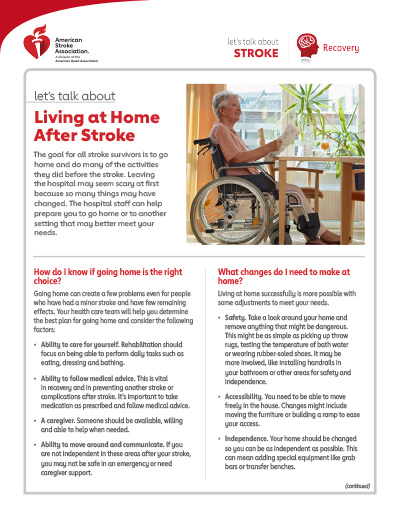Let’s Talk About Living at Home After Stroke
 The goal for all stroke survivors is to go home and do many of the activities they did before the stroke. Leaving the hospital may seem scary at first because so many things may have changed. The hospital staff can help prepare you to go home or to another setting that may better meet your needs.
The goal for all stroke survivors is to go home and do many of the activities they did before the stroke. Leaving the hospital may seem scary at first because so many things may have changed. The hospital staff can help prepare you to go home or to another setting that may better meet your needs.
How do I know if going home is the right choice?
Going home can create a few problems even for people who have had a minor stroke and have few remaining effects. Your health care team will help you determine the best plan for going home and consider the following factors:
- Ability to care for yourself. Rehabilitation should focus on being able to perform daily tasks such as eating, dressing and bathing.
- Ability to follow medical advice. This is vital in recovery and in preventing another stroke or complications after stroke. It’s important to take medication as prescribed and follow medical advice.
- A caregiver. Someone should be available, willing and able to help when needed.
- Ability to move around and communicate. If you are not independent in these areas after your stroke, you may not be safe in an emergency or need caregiver support.
What changes do I need to make at home?
Living at home successfully is more possible with some adjustments to meet your needs.
- Safety. Take a look around your home and remove anything that might be dangerous. This might be as simple as picking up throw rugs, testing the temperature of bath water or wearing rubber-soled shoes. It may be more involved, like installing handrails in your bathroom or other areas for safety and independence.
- Accessibility. You need to be able to move freely in the house. Changes might include moving the furniture or building a ramp to ease your access.
- Independence. Your home should be changed so you can be as independent as possible. This can mean adding special equipment like grab bars or transfer benches.
What if I can’t go home?
Your doctor might suggest a move from the hospital to another type of facility which meets your needs until you are ready to go home. It’s important that the place you live is safe and supports your continued recovery. Your social worker or case manager at the hospital will help with information about different types of facilities, which can include:
- Inpatient rehabilitation facility (IRF). Inpatient rehabilitation may be located independently or may be part of a large hospital complex. These facilities offer an intensive, coordinated rehabilitation program and are recommended for best patient outcomes. IRFs often include at least three hours per day of active therapy, five or six days a week. This type of setting can help you reach your goals, including building strength, confidence and independence. Inpatient facilities offer a wide range of medical services, including 24-hour doctor supervision and access to a variety of therapists.
- Skilled nursing facility (SNF). This type of setting follows a physician’s plan, provides some therapy and supportive nursing care 24 hours a day.
- Nursing facility. This can be a good choice for someone who has ongoing medical problems and needs more care than a caregiver can provide at home. This type of facility provides nursing care 24 hours a day and access to rehabilitation services as needed.
- Assisted living. This is for people who can mostly live on their own but need some help with things like meals, medication and housekeeping.
How can I learn more?
- Call 1-888-4-STROKE (1-888-478-7653) or visit stroke.org to learn more about stroke or find local support groups.
- Sign up for our monthly Stroke Connection e-news for stroke survivors and caregivers at StrokeConnection.org.
- Connect with others who have also had an experience with stroke by joining our Support Network at stroke.org/SupportNetwork.
Do you have questions for your doctor or nurse?
Take a few minutes to write down your questions for the next time you see your health care professional. For example:
What living arrangement would you recommend for me?
Is there a caregiver or stroke support group available in my community?
We have many other fact sheets to help you make healthier choices, manage your condition or care for a loved one.
Visit stroke.org/LetsTalkAboutStroke to learn more
© Copyright 2023 American Heart Association, Inc., a 501(c)(3) not-for-profit. All rights reserved. American Stroke Association is a registered trademark of the AHA. Unauthorized use prohibited. WF355929 10/23